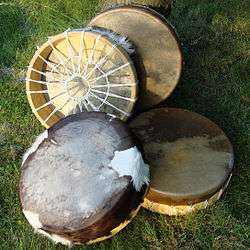Pandeiro
The pandeiro (Portuguese pronunciation: [pɐ̃ˈdejɾu]) is a type of hand frame drum popular in Brazil to the point that it has been described as the unofficial instrument of that nation, and is mentioned in the song, "Aquarela do Brasil". The pandeiro is used in a number of Brazilian music forms, such as samba, choro, coco, and capoeira music. The Brazilian pandeiro derives from the pandeireta or pandereta of Spain and Portugal.
 | |
| Percussion instrument | |
|---|---|
| Classification | Frame drum |
| Hornbostel–Sachs classification | 211.311 (Directly struck membranophone) |

The drumhead is tunable, and the rim holds metal jingles (platinelas) which are cupped, creating a crisper, drier and less sustained tone on the pandeiro than on the tambourine. It is held in one hand, and struck on the head by the other hand to produce the sound. Typical pandeiro patterns are played by alternating the thumb, fingertips, heel, and palm of the hand. A pandeiro can also be shaken to make sound, or one can run a finger along the head to produce a drum roll.
Medieval instrument
The term pandeiro was previously used to describe a square double-skinned frame drum, often with a bell inside; such an instrument is now known by the term adufe in Spain and Portugal. It is derived from an earlier Arabic or Moorish instrument still found in North Africa.[1]
The term pandeiro (pandero in Asturian) is still used in parts of Galicia and Portugal to describe the square-shaped drum, while the round drum with jingles is known as pandeira in Galicia.[2]
Players

Some of the best-known pandeiro players today are Paulinho da Costa, Nanny Assis, Airto Moreira, Marcos Suzano, Cyro Baptista, Zé Maurício, and Carlinhos Pandeiro de Ouro.
Another notable pandeiro player was Milt Holland, a Los Angeles-based studio percussionist and drummer who travelled the world extensively to collect and study various ethnic percussion types.[3][4]
Non-traditional usage
Artists such as Stanton Moore use it non-traditionally by tuning it low to sound like a bass drum with jingles, mounting it on a stand and integrating it into the modern drum kit. Others, such as Sule Greg Wilson on the Carolina Chocolate Drops album Genuine Negro Jig, use it in tandem with a tunable bodhran — also mounted — and play them as a pair with brushes to create drum kit effects, as well as their original intent as hand-held percussion.
References
- "Archived copy". Archived from the original on 2016-03-17. Retrieved 2006-05-17.CS1 maint: archived copy as title (link)
- Mauricio Molina (2006). Frame Drums in the Medieval Iberian Peninsula. ProQuest. pp. 101–. ISBN 978-0-542-85095-0. Retrieved 25 December 2012.
- Dickinson, Jim (2017-03-23). I'm Just Dead, I'm Not Gone. ISBN 9781496811202.
- "Milt Holland | Credits". AllMusic. AllMusic, member of the RhythmOne group. Retrieved 19 January 2020.
External links
| Look up pandeiro in Wiktionary, the free dictionary. |
